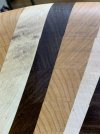I’ve been working this weekend on turning a bandsaw bowl. The piece is made of Peruvian walnut, maple, and cherry. I’m not thrilled with the result, but I can chalk it up as a learning experience.
One of the problems — I think — is that when sanding, dust from the very dark walnut filled the pores of the lighter woods, leading to the streaks and discoloration shown here.
Is my suspicion correct? Would the use of sanding sealer or shellac — I’m thinking something to fill the pores before sanding — have helped to prevent this? Any other hints or suggestions?
One of the problems — I think — is that when sanding, dust from the very dark walnut filled the pores of the lighter woods, leading to the streaks and discoloration shown here.
Is my suspicion correct? Would the use of sanding sealer or shellac — I’m thinking something to fill the pores before sanding — have helped to prevent this? Any other hints or suggestions?

